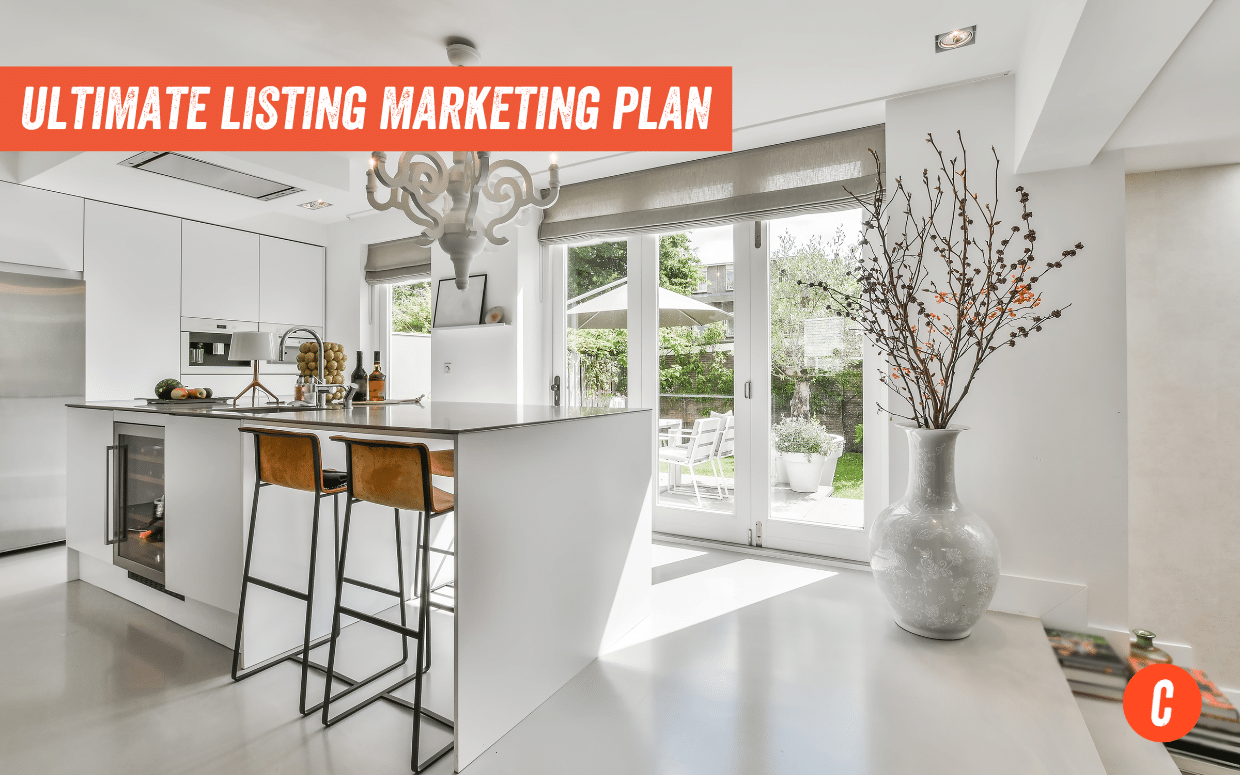Your listing marketing plan is one of the most powerful tools you have as a seller’s agent. It maps out exactly where, how, why, and when you’ll promote your client’s home. If you haven’t created one yet, I’m sharing our 10-point Ultimate Real Estate Listing Marketing Plan to help you look like a rock star in your listing presentations. With it, you can confidently list any property — including luxury ones — and convince every seller that you’re the agent to get their property sold.
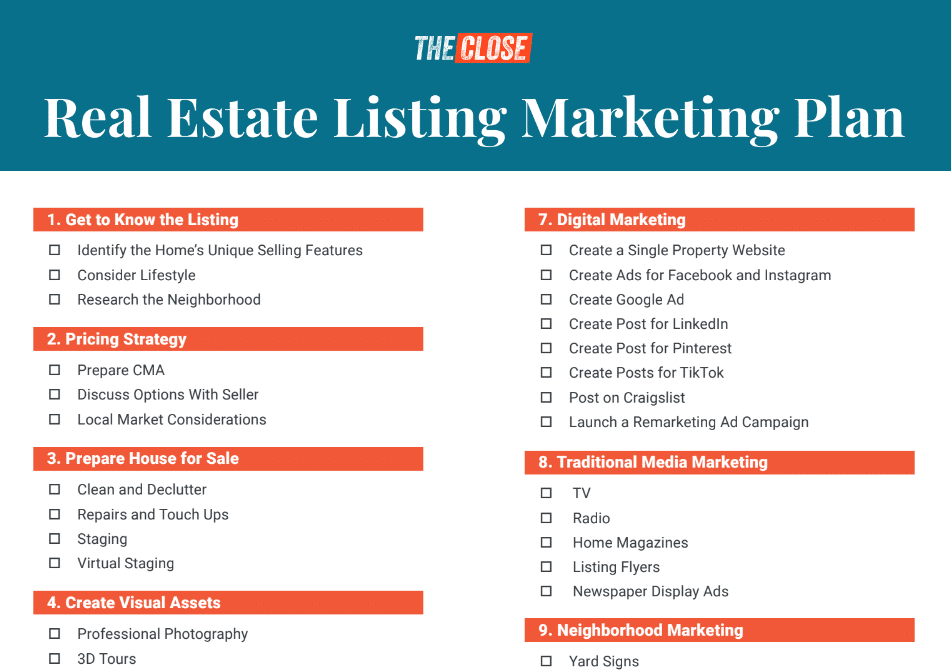
1. Understand every feature, flaw, & selling point of the property
You can’t market a home you barely know. Before you even think about writing the listing or creating your real estate marketing plan, you’ve got to know the home like the back of your hand. What makes it shine? What quirks might raise eyebrows?
- Identify the home’s unique selling features: Talk to your seller and get specific about the spaces they’ve enjoyed the most. Features like a remodelled kitchen or custom built-ins can set the tone when you start writing creative listing descriptions.
- Consider how the property fits a buyer’s lifestyle: Is this home ideal for remote workers, growing families, or downsizing retirees? Use location and amenities to frame the home in a way that speaks directly to the people who’ll see the most value in it.
- Research the neighborhood: Dig into local highlights like nearby employers, schools, transit access, airports, and development plans. However, be mindful to comply with all fair housing laws when interacting with your clients.
2. Develop a data-driven pricing strategy
- Prepare a detailed CMA: The comparative market analysis (CMA) is one of the best tools in your real estate listing marketing plan because it gives you and your clients tangible data to base pricing on. Get a baseline of value for the listing, then discuss options for pricing above or below market value.

- Discuss options with the seller: Break down the impact of each approach, such as going slightly above market, pricing at value, or dipping just below to spark interest. Be clear about what each move might mean in terms of showings, buyer urgency, and days on market.
- Layer in current market considerations: Research days on market, current pricing, new construction, mortgage interest rates, and changes in the community. These details can significantly influence buyer behavior and should inform how you market the home from the outset.
3. Prepare the house for sale by maximizing its appeal
- Clean and declutter: Guide your sellers on what to pack away, especially anything overly personal. Once the space is clear, bring in pros for a deep clean to make the home feel fresh and move-in ready.
- Handle minor repairs and touch-ups: Recommend changes that offer a visual impact without incurring significant costs. Be honest about what’s worth fixing and what might not be worth the investment.
- Boost curb appeal: From planting fresh flowers to power washing the front walk, minor updates can make a big first impression. If the exterior still requires improvement, consider adding visual enhancements to elevate it further.
- Use staging to bring the space to life: If the house is vacant or the decor is subpar, consider staging your listing or hiring a professional staging company to add context to empty or not-so-appealing spaces. Staging is a must-have in your real estate listing marketing plan for luxury homes in particular.
- Offer virtual staging when needed: If traditional staging isn’t in the budget, an alternative is virtual staging, which can also be done for vacant or furnished homes. Use a professional company like Apply Design to give your vacant listing a stunning makeover.

4. Create and collect high-quality visual assets
Strong visuals are non-negotiable. Buyers are scrolling through dozens of listings, and your photos and videos need to stop the scroll. Here are a few must-haves to build out your visual real estate listing checklist:
- Professional photography: Bring in a real estate photographer to create stunning images that showcase the best angles and lighting. If you’re shooting it yourself, brush up on photo composition, lighting, and some editing basics. Check out our real estate photography guide for some tips for stunning listings.
- 3D Tours: Invest in 3D virtual tours to provide buyers with an interactive tour experience. Using software like Matterport will ensure that you’re able to create a stellar experience for potential buyers. Visit Matterport to learn more about it, or check our best virtual tour software guide for more options.
- Promo videos and virtual tours: Shoot short vertical videos with music and text overlays for Instagram Reels, TikTok, or YouTube Shorts. Simple walkthroughs shot on your phone can perform surprisingly well.
- Aerial photography and video: Use drone shots to capture a broader view of the property, neighborhood, and surroundings. This is particularly helpful if the home is located near key landmarks, such as the beach, a golf course, or a university.
5. Create a listing & post everywhere
Your listing deserves maximum exposure, and that means showing up everywhere buyers are looking — locally, regionally, and online. From your property description to syndication, every detail matters. Here’s how to get it out in front of the right audience:
- Write a compelling property description: Focus on the lifestyle the home offers using descriptive real estate words that help buyers picture themselves living there.
- Upload to your local multiple listing service (MLS): Post your listing on your local MLS with images from your pro photographer. Details matter, so double-check every field before hitting publish.
- Feature it on your brokerage and personal websites: If you have a website, prominently feature the listing on the homepage with a strong call to action to generate inquiries.
- List it on nearby MLSs: For homes near city or county borders, posting to multiple MLSs can expand visibility.
- Syndicate to major listing platforms: Include permission for your listing to be syndicated to other sites like Zillow, Trulia, and Realtor.com for broader reach.
- Prepare a listing book: Assemble a book that includes neighborhood amenities and community insights. Add more in-depth information about your listing and make the book attractive. It’s a great tool to leave out during showings or open houses.
6. Host open houses
Open houses can create buzz and bring in serious buyers when done right. Whether you’re drawing a weekend crowd or offering a more private experience, the key is creating a smooth showing and following up with purpose.
- Kick things off with a traditional open house: Plan a well-promoted event that feels like a grand opening. Coordinate timing with your seller, have the home spotless, and use a tool like Curb Hero to collect visitor info.
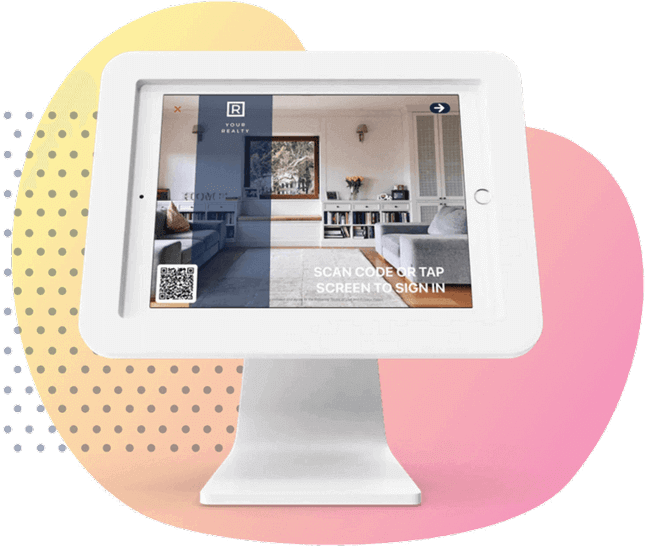
- Offer a virtual option for remote buyers: Schedule a virtual open house through platforms like Facebook or Instagram Live and invite attendees from outside the local area.
- Host by-appointment-only showings when needed: If the seller prefers more control or privacy, set time blocks for individual buyers. This gives you space to engage more and guide the experience.
- Follow up with open house attendees: Reach out to them soon after the event to thank them, solicit their feedback, and address any questions they may have. Personal follow-ups help turn casual interest into potential offers.
7. Leverage digital marketing channels
Digital marketing is all about showing up in the right places, with the right message, for the right audience. Develop a strategic approach that leverages both organic reach and targeted advertising.
- Create a single-property website: Use Canva for a quick, low-cost site or explore luxury-focused platforms like Sierra Interactive for something more elevated. Don’t forget to include lead capture forms to turn traffic into inquiries.
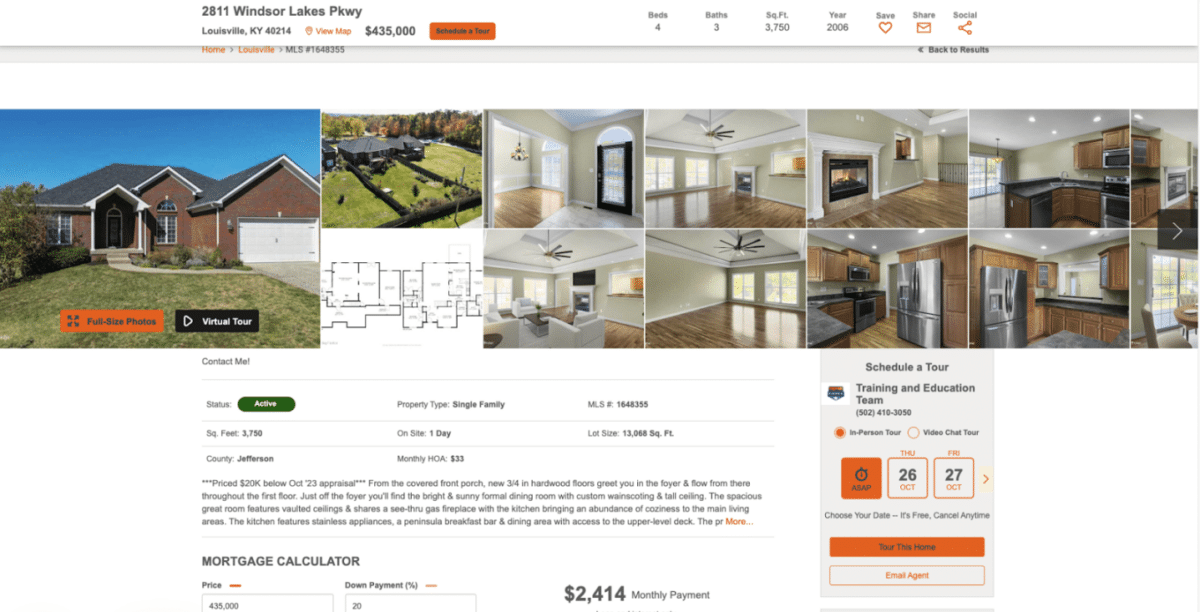
- Run real estate ads on social platforms: Use Meta Business to promote your listing across Facebook and Instagram. Create your ads, set your budget, and you’re all set.
- Post in real estate Facebook groups and Marketplace: Listings shared in local or niche groups can drive organic interest, especially when paired with eye-catching visuals.
- Tap into Google Ads for high-intent traffic: Whether through your setup or tools like Real Geeks or Sierra Interactive, Google’s targeting power helps you reach buyers actively searching in your market.
- Showcase your expertise on LinkedIn: Use this platform to promote investment opportunities or demonstrate your local market knowledge to your professional network..
- Create scroll-stopping visuals for Pinterest and Instagram: Pin or post listing photos and link directly to your lead capture pages. These platforms are perfect for visual-first engagement.
- Show some personality on TikTok: A quick video (set to trending audio) of a unique listing feature — a swimming pool, gourmet kitchen, or a sunset from the deck — can reach a whole new audience.
- Post on Craigslist: You may not think of Craigslist when you start mapping out your marketing strategy, but don’t discount how many eyeballs you can capture on the platform for your listing.
- Launch remarketing campaigns: One of the most effective strategies for efficient digital marketing is remarketing, which reengages your existing customers through targeted email or paid ads. You can do this through your Google Ads account.
8. Utilize traditional media outlets
Digital marketing might get most of the buzz, but traditional media still has its place. From print to radio, these outlets can add reach and credibility to your listing campaign:
- Run local TV ads: Use the power of TV advertising to reach your audience who doesn’t spend all their time on their phones. Depending on your target demographic, TV ads may produce powerful results and are a great asset to your overall listing marketing plan.
- Place radio spots with broad community reach: Consider sponsoring segments or running short promos on popular radio stations in your area. Think about tying it to your brokerage branding.
- Advertise in regional or luxury home magazines: These glossy spreads often land in the hands of serious buyers. Plus, sellers love seeing their home in print.
- Print real estate flyers with CTAs: Design high-quality flyers for your listing that highlight the features, along with a QR code for more information.
- Use newspaper display ads for extra visibility: Local newspapers still draw attention. Sellers love seeing their listings in print. And newspapers have digital display ads online, too!
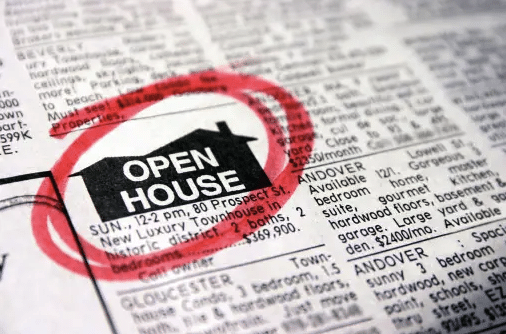
9. Implement targeted neighborhood marketing
Don’t overlook the power of local buzz. Clever neighborhood marketing can increase foot traffic, spark word-of-mouth referrals, and show nearby homeowners that you’re the go-to agent in their area. It’s old school, but still incredibly effective when done right.
- Use high-quality yard signs: As part of your real estate marketing listing checklist, ensure your yard signs are in excellent condition and represent your image professionally.
- Add QR codes for easy digital access: Link directly to your listing site or virtual tour. Create sleek, branded codes using tools like Canva.
- Try geo-targeted ads around the property: Use a geofencing marketing company to advertise to those who come within the perimeter of your property.
- Branded directional signs: Invest in branded directional signs to stand out and attract more buyers to your open house.
- Postcards and door hangers: Use a company like ProspectsPLUS to create marketing postcards for your listing and send them out with just a few clicks.
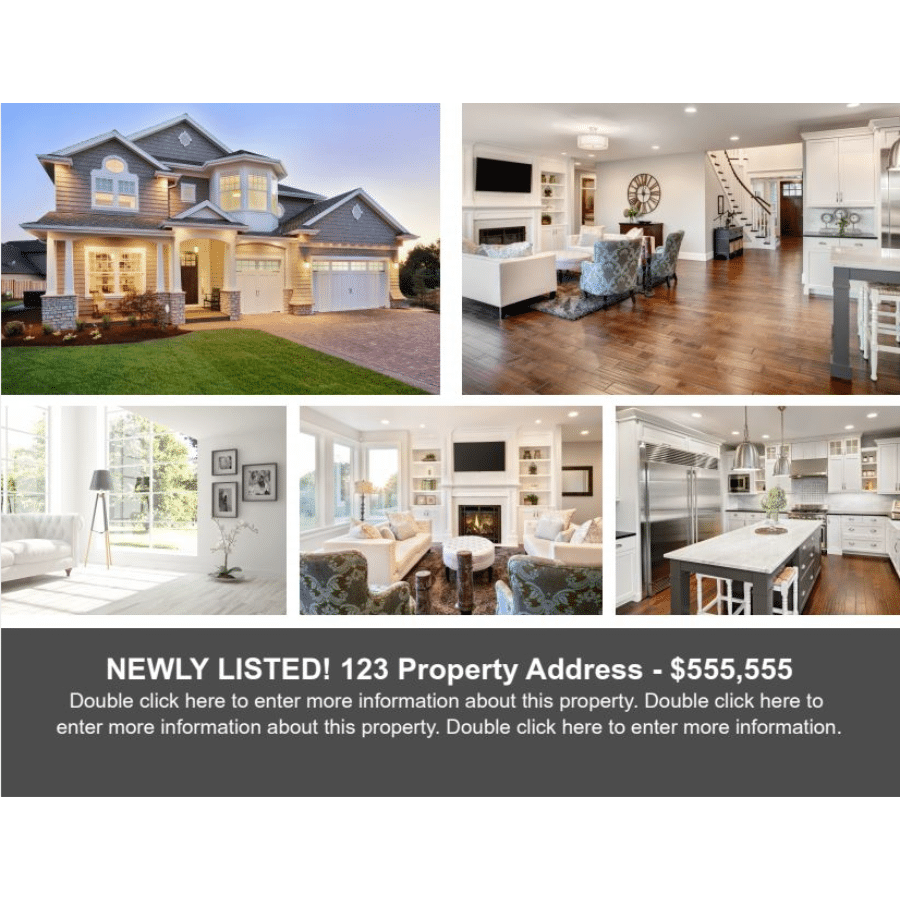
- Generate more leads through circle prospecting: Get out and knock on doors around your open house to encourage people to visit. “Lookie-loo” neighbors sometimes bring referrals, so make nice with them.
10. Market to your sphere of influence
Your personal network is one of your strongest marketing tools. Past clients, colleagues, fellow agents, and community contacts can help spread the word and offer feedback. Don’t be shy — always keep your circle in the loop.
- Start with your office: Spread the word about your listing to everyone you already work with. They may have a buyer who is the perfect fit.
- Market to outside agents and brokerages: Post in industry Facebook groups, message boards, or agent networks where peers gather and share inventory.
- Send a dedicated email blast to your sphere: Whether it’s a one-time send or part of your regular newsletter, ensure your contacts hear about the listing.
- Loop in local businesses: Reach out to small business owners and community partners who might help spread the word.
- List on a broker tour or caravan: Showcase your listing through your local broker tour. Create feedback forms for agents to share their thoughts on how you can improve your listing.
- Update your seller client weekly: Even if there’s nothing new to report, consistent communication is vital for a solid working relationship.
Bonus: Apply specialized strategies for marketing luxury listings
Luxury listings call for a higher level of presentation and promotion. Everything, from your branding to your materials, should reflect the premium experience buyers expect at this level.
- Polish your brand: If you’re breaking into the luxury market, you’ll want to make sure your brand is ultra-high-quality. Everything from your logo to listing materials should signal quality, exclusivity, and attention to detail.
- Invest in a custom video: Hire a pro to create a cinematic property tour with aerial shots and voiceover narration.
- Level up your real estate brochure game: Skip the one-pagers. Go for thick, high-gloss cardstock and multi-page layouts that feel like mini coffee table books.
- Market beyond your ZIP code: List nationally and internationally to attract vacation home buyers and home investors. Reach out to agents in other luxury markets who might have interested clients.
- Host a high-end broker’s open: Invite top agents who have worked similar price points, serve upscale food and drinks, and consider small gifts as thank-yous.
Frequently asked questions (FAQs)
How to create a marketing plan for real estate?
Start by thoroughly understanding the property inside and out, then develop a comprehensive plan that includes a pricing strategy, effective staging, high-quality visuals, and a distribution strategy across both digital and traditional channels. Remember to tailor your approach to the specific type of property, target buyer, and prevailing market conditions.
How do I market my listings?
Use a mix of professional photos, videos, single-property sites, social media, email marketing, and open houses. The key is showing up consistently where buyers are already looking.
How do I get my listings noticed?
Excellent visuals and targeted marketing make all the difference. Promote across multiple channels, write compelling descriptions, and don’t forget to tap into your sphere and agent network to spread the word.
Bringing it all together
In the current market, learning how to put a real estate marketing plan for sellers together and execute it will make a big difference in your level of success. What strategies do you use in your real estate listing marketing plan? Let me know in the comments!







